The Heritage of Tasmania: Southern Region - Bothwell
[Previous Post: National Trust Tasmanian Heritage Register 8 .... Next Post: National Trust Tasmanian Heritage Register 10 ]
Table of Contents

This post is derived from "The Heritage of Tasmania; The Illustrated Register of the National Estate" (Macmillan, Melbourne 1983)
The Tasmanian National Trust Heritage list has been 'rescinded' by the State Government, so on these pages I have started to reconstruct it.
- Southern Region
- South West Tasmania
- Western Region
- North West Region
- North East Region
1. Southern Region of Tasmania
- Bothwell: 17 of National Heritage + 8 more rural properties
+ 49 registered by the Tasmanian National Trust
+ Map of Bothwell with 69 Historic places: - Brighton (next page)
- Bruny (following page)
- Clarence (following page)
- Esperance (following page)
1. Bothwell Historic Town, Tasmania
Listed on the Register of the National Estate
|
|
| ||||||
|
|
| ||||||
|
|
| ||||||
| These images from: http://www.aussietowns.com.au/town/bothwell-tas | ||||||||
- The general character of the town is one of looseness, internal open spaces being important, with consistent architecture generally in good condition.
- The settlement is important for its formal layout which is emphasised by continuing civic consciousness in building and landscape."
Bothwell Historic Town is an agricultural settlement on the Clyde River, set in a modified landscape, surrounded by low naturally vegetated hills.
The Australasian Golf Museum in Patrick Street, Bothwell - Consistently it is a loose grid plan settlement with large lot sizes. Civic details include avenue plantings and Queens Square.
- Dense pine plantings occur en route to the showground.
- Important homesteads occur on the west side of the river.
- It has two village centres, with fine churches and cemeteries grouped about Queen's Square.
- Read more: http://think-tasmania.com/bothwell/
- On the Convict Trail blog - Bothwell
- Aussie Towns - Bothwell
- Further reading: John Seymour WEEDING: A History of Bothwell, 106pp, b&w photographs. Stapled in wrappers, as issued.
- Read more about Bothwell and other Historic Towns here
Bothwell (population 350) considers itself the 'gateway to the highlands', being the last service, educational and administrative town before theCentral Plateau recreational area.
Bothwell Historic Town, TAS - Bothwell is a classified historic town. Located in a broad river valley at an altitude of 300 metres, its Scottish namesake also bestrides the River Clyde.
- The first settlers, predominantly Scottish, who arrived in 1822, built sturdily, farmed successfully and quarrelled heatedly.
- The Bothwell Literary Societywas early established, as were churches and schools.
- The Irish patriot John Mitchel spent time here. Convicts assigned to the area stayed to form the town's commercial and labouring core.
- The oldest golf course in Australia is at Ratho, complemented by the Australasian Golf Museum.
- The area has always depended on primary industry, but the emphasis changed in the late twentieth century from purely pastoral to include extensive cropping areas.
 |
| Bothwell Township |
Bothwell Historic Town is one of the most historically significant towns in Tasmania with a total of 60 buildings and locations of significant historic interest.
- The Visitor Information Centre has a small brochure titled Let's Browse in Bothwell which provides a useful map to the town as well as short descriptions of the places of interest around the town.
- Sheep grazing and beef cattle properties are predominate throughout the surrounding areas. There is also a variety of new industries operating to support the traditional farm based enterprises. These include tulips, cereal grains crops, poppies, pyrethrum, strawberries and sheep and goat cheese making. Bothwell also relies on its historic value to attract visitors.
There are over 40 Australian Heritage Registered properties at Bothwell:
they are linked to the 25 properties listed by the National Trust below;
National Trust Registered structures in Bothwell
(25 listed in 1983 publication: The Heritage of Tasmania, pages 10-12)1. Former Post Office, Patrick Street, Bothwell
- A small Georgian building, former post office, with ashlar stone facade. The rest of the building is brick with stone reveals and quoins.
2. Post Office and Residence (Van Diemen's Land Bank), Bothwell
10 Alexander Street, Registered- An unusual and highly memorable Victorian timber building constructed in 1891 as the Van Diemen's Land bank and residence.
- Sale listing and photographs.
- The richly detailed facades of the bank, and the numerous other quality details throughout, are a fine testament to the capacities of the responsible Victorian carpenters and their craft. This corner building is a focal element contributing to the townscape of historic Bothwell.
3. Bothwell Emergency Control Centre,
also known as Literary Society Building Classified - 57 Alexander St, Bothwell (see below)4. St Luke's Uniting Church, 104 Dennistoun Road Bothwell
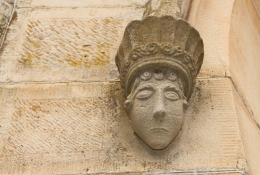
St Luke's Presbyterian Church (1831) Bothwell - St Luke's Presbyterian Church, now St Luke's Uniting Church, is also located in Market Place.
It was designed in 1828 and completed in 1831. Of particular interest are the carvings above the main doorway:
Daniel Herbert, the genius convict stonemason-sculptor who carved the images on the sides of the bridge at Ross, is credited with creating these strange images which may depict a Celtic pagan god and goddess.- Herbert was known for his droll sense of humour. If they are pagan it is amusing to note that Governor Arthur upon inspecting the church ordered the architect, John Lee Archer, to change the rounded windows because they were 'unchristian'.
- Herbert was known for his droll sense of humour. If they are pagan it is amusing to note that Governor Arthur upon inspecting the church ordered the architect, John Lee Archer, to change the rounded windows because they were 'unchristian'.
5. St Michael's Church, Patrick Street Bothwell
A fine stone Gothic Revival church built by Thomas Lewis, stonemason, in 1891 to a design of Launceston architect Alexander North.The church has a square tower with a circular stone staircase expressed externally. It occupies an important site opposite Queens Square.
6. Dr J. Brennan's Surgery,Also known as the Coffee Palace.
90 Dalrymple Street Bothwell;- A two storey brick and stucco Georgian building with a stone rear section, licensed as the Young Queen from 1851-1877 when the name was changed to Maskell's Hotel.
- The house was constructed in 1831 for Sandy Denholm, a blacksmith. It is a two storey brick and stucco Georgian building with a stone rear section, It was first licensed in 1836 as The Falls Of Clyde, later called The Young Queen from 1851–1877 when the name was changed to Maskell's Hotel.
- By the late 1800’s the building was known as The Coffee Palace, a coffee house hosting accommodation forming part of the temperance movement from the mid 19th century. Read more at On the Convict Trail blog.
7. Former Tannery, Lake Highway, Bothwell
A group of three single storey stone vernacular buildings formerly used for the tanning of skins and hides.The buildings occupy a fine site on the western bank of the Clyde River.
8. (Whites') Store and Shop,
124 Queen's Square, Bothwell, also known as 20 Alexander Street Bothwell Tas 7030 - Sale listingThe shop has a street verandah and stone footpath paving and its important corner location opposite Queen's Square gives the building focal importance to the historic Bothwell townscape.
9. Bothwell Stores 66 Alexander Street Bothwell
A two storey brick Georgian corner building, constructed as two shops and residence.- The building is notable for its shopfronts, steeply pitched roof and stone paving to footpath outside. The building is a focal element of the Bothwell townscape.
10. Fort Wentworth, Lake Highway, Bothwell
The house was built in 1832, and in 1849 alterations were made to allow its use as a police office and watch-house.It is perhaps the best sited of buildings, sitting on a rocky knoll with fine east views over the Clyde River and Bothwell township.
11. 'Wentworth House', Wentworth Street, Bothwell
 |
| 'Wentworth House', Wentworth Street, Bothwell |
'Wentworth', on Wentworth Street was built for one of the town's early Police Magistrates, Major D'Arcy Wentworth.
It is a gracious two storey home built in 1833 and originally known as Inverhall.
- D'Arcy Wentworth was the brother of William Charles Wentworth (who achieved fame when he was one of the first Europeans to cross the Blue Mountains)
12. Stone Cottage, corner 97 Dennistoun Road Bothwell
13. Stone residence and outbuildings, 8 Patrick Street, Bothwell
A stone Georgian cottage built about 1860 with a later Victorian timber verandah, this building was once used as a post office. The stone coach house at the rear was a staging point for local coaches. The buildings are important townscape elements of historic Bothwell.
 |
| Clifton Priory, Lake Highway, Bothwell |
14. Clifton Priory, Lake Highway, Bothwell
- Two storey stone Tudor Gothic house built in 1847-8 by Rev. Robert Wilson from public subscription.
- Wilson caused a scandal when he ran into financial difficulties and sold it owing a considerable sum.
- The house is magnificently sited on Barrack Hill from where it enjoys fine views of Bothwell, the Clyde River and surrounding countryside.
- Read all about Clifton Priory
15. Mitchel's Cottage (Nant Cottage), Nant Road, Bothwell
- A single storey brick Georgian cottage once occupied by Irish exilesJohn Martin and John Mitchel.
16. Barn on Steddles, Elizabeth Street, Bothwell
- An unusual and scarce timber barn built on stone steddles to prevent vermin entering the metal lined grain store. The barn was built in the 1860's on the property 'Grantham'.
17. Ratho Homestead and Outbuildings,
- Lake Highway north of Bothwell'Ratho', which lies to the west of the town on Highland Lakes Road, is a single storey stone house with wooden Ionic columns at the front.
- Built in the 1830s to a design by architect Andrew Bell it was the home of Alexander Reid.
- Ratho's great claim to fame is that the Ratho Golf Course is the oldest course in Australia and the oldest known course outside Scotland.
- Ratho is still a working farm with "grazing sheep maintaining the fairways and fences.
 |
| Ratho Farm and Golf course |
 |
| Ratho Homestead and Outbuildings |
- Built in the 1830s to a design by architect Andrew Bell it was the home of Alexander Reid. Ratho's great claim to fame is that the Ratho Golf Course is the oldest course in Australia and the oldest known course outside Scotland.
- Laid in the mid-1830s, the course has square putting greens and fairways maintained by grazing sheep. You can even play a round with traditional hickory clubs.
 |
| Putting greens and fairways maintained by grazing sheep |
Other Bothwell Area Properties National Trust Registered
| Thorpe Mill, Bothwell | 'Cluny Park' Homestead, | 'Llanberis' (formerly Calton Hill) | 'Sherwood' Homestead | 'Strathborough |
1.Thorpe Mill, Bothwell
2. 'Cluny Park' Homestead,
north-west of Bothwell - Home of Captain William Clark, late of the 6th Regiment of Foot, of the Clark property, Cluny Park, Bothwell- A two storey Tudor Gothic sandstone house built in 1830 onto an existing single storey mudstone cottage (still surviving) built in 1824 by Captain William Clark on land granted to him. The house has aspects indicating continuous development until recent times.
Mudstone, single storey section at rear 1824. Two storey sandstone 1830 - Tudor Gothic - iron gable roofs - Lotus chimney pots. Projecting bay windows. Two pane windows - replacements. Decorative barge. Front door and roof dormer added c1960. Sunroom addition.
3. 'Llanberis' (formerly Calton Hill) 1519 Hollow Tree Road, south-west of Bothwell
A two storey stone Gothic Revival house incorporating a cottage built before 1875. The twin gabled sections were added about 1890. The house, with its verandah to three sides, is well sited on a low knoll. Its setting in the landscape is remarkable and memorable, with the house outlined against a background of close hills while the view from the house is an open distant view across the Clyde.
Sandstone Gothic Revival house. Double gables with central chimney rising from valley. Timber verandah to three sides with timber posts and brackets. Built in front of earlier cottage. Quoins and reveals expressed. Two pane windows. Very good setting in landscape on knoll with treed background.
4. 'Sherwood' Homestead, Hollow Tree Road, south-west of Bothwell
A fine Colonial stone house and attached stone outbuildings erected in 1842 on land granted to John Sherwin in 1823. The house has been subject to visits from bushrangers, among them Martin Cash in 1843. The group is dramatically sited in a deep valley of the River Clyde on an old road along the river to Bothwell.
Two storey stone Georgian house with attached stone outbuildings. Iron hip roofs. Thirty pane windows to level one, sixteen pane to level two. Cellars. Main facade of three bays with central entrance of six panel door, half sidelights and fanlight. Attached stone outbuildings 'in line' include two storey stone barn. Also two storey stone cottage. Many stone walls. Fantastic site deep in Clyde valley.
5. 'Strathborough' 1519 Hollow Tree Road, Hollow Tree
A two storey Georgian stone house built in 1835. The house has unusual buttressing and protruding walls suggesting that the front facade may have been rebuilt. The building has a good setting in the landscape.
Two storey stone Old Colonial Regency house. Finer paler stone to front facade which protrudes at ends. North and south walls are buttressed - front door has deep recess - all this indicates the front wall has been rebuilt. Five bays, two pane windows. Single storey kitchen wing at rear. Also long stone wall at rear - now incorporated into recent outbuildings.
6. 'Strathbarton' (The Black Marsh), Lower Marshes Road, north of Apsley
A very unusual Georgian house and outbuildings erected in 1858 by Andrew Bell for Rev. Robert Russell.- The two storey stone house has an unusual entrance porch with Doric balcony and a crude art nouveau timber verandah added later.
7. St James Church, Montacute (a hamlet)
A simple Gothic Revival stone country church, built in 1857 by Captain William Langdon R.N. as part of the Montacute Estate.- Read all about St James Church, Montacute

The beautiful stone church of St James, Montacute. On 11 January 2004
8. Steppes State Reserve, near Bothwell
Original cabin, the home of James Wilson, aged between 90 and 100 years, split boards, three rooms, much dilapidated but repairable: overhung with ivy and old fruit trees facing picket fence about garden.Log cabin, (used as a living room and bakehouse), aged paling roof, large stone fireplace one end, bakers oven in boulder stone at opposite end
 |
| Bothwell Historic Village -1. Originally a Gothic style schoolhouse, now the Australian Golf Museum. 2 the Old Stores, circa 1850. 3. The Castle Hotel, circa 1829 4. Twin Cottages, circa 1850 |
National Trust of Tasmania Register List for Bothwell, Tasmania

(from "The Country Towns and Villages of Tasmania" Register of Listed Buildings, edited by J.N.D. Harrison, Hobart 1976)page 60
These total 30 in Bothwell and 18 in the Country around Bothwell (=48). (The Tasmanian Heritage Register lists approx. 59 properties)
High Street, Bothwell
- Brick Residence (1839) (D.C. Medhurst) Classified
Elizabeth House, High St, Bothwell, TAS, Australia - Stone Cottage (W. Barwick) Classified
- Stone Cottage (J. Denholm) Classified
- Brick Cottage with Slate Roof (C.M. Campbell) (1837) Classified
- Brick Residence (1839) (D.C. Medhurst) Classified
Patrick Street, Bothwell
Castle Hotel
(c. 1829) and Hall (c. 1892) (C, Clark) Registered
The Castle Inn dates from 1829 and is recognised as the second oldest continuously licensed hotel in Tasmania.
So old is the hotel that there is evidence that local Aborigines performed a corroboree in front of the hotel in 1832.Stone Residence and outbuildings, 8 Patrick Street (J. Bignell)
Classified
A stone Georgian cottage built about 1860 with a later Victorian timber verandah, this building was once used as a post office.
The stone coach house at the rear was a staging point for local coaches. The buildings are important townscape elements of historic Bothwell.
Market Place and Queen Street, Bothwell
- St Luke's Presbyterian Church, by architect J. Lee Archer (1831) Classified
St Luke's Presbyterian Church, now St Luke's Uniting Church, was designed in 1828 and completed in 1831. - Store and Shop (corner Alexander Street, 124 Queen Street Bothwell) (Miss White) Classified
- Library (Old State School) Registered
- read more: On the Convict Trail:Bothwell Literary Society Building
Stone Residence (Old Headmaster's House)
Registered
The old Bothwell State School operated from 1887 until 1965. For most of its life it was operated as a two teacher school.
At the official opening of the school, two trees were planted, an oak & a lime. Probably the two trees that currently are situated near the road are those original trees.
Read More at On the Convict Trail - Old State School, Bothwell
- St Luke's Presbyterian Church, by architect J. Lee Archer (1831) Classified
- Dennistoun Road, Bothwell
- Stone Cottage: Rock Cottage, 94 Dennistoun Road Bothwell, (corner Alexander Street) (W. Nichols) Classified
A single storey rusticated stone Victorian cottage built by local mason, Thomas Lewis.
The building is located at the end of Queen's Square and is an important focal element of the townscape of historic Bothwell. - Stone Cottage 97 Dennistoun Road Bothwell (C. L. Campbell) Classified
- Stone Cottage: Rock Cottage, 94 Dennistoun Road Bothwell, (corner Alexander Street) (W. Nichols) Classified
Alexander Street, Bothwell
Two Brick Cottages (Mrs. G. E. Sealy)
ClassifiedBothwell Stores 66 Alexander Street Bothwell.
A two storey brick Georgian corner building, constructed as two shops and residence.
The building is notable for its shopfronts, steeply pitched roof and stone paving to footpath outside. The building is a focal element of the Bothwell townscape(White's) Store (corner Dalrymple Street)
(Mrs. G. E. Sealy)Classified - 20 Alexander Street Bothwell Tas 7030 - Sale listingLiterary Society Building (Bothwell Council)
Classified - 57 Alexander St, Bothwell
A single storey brick Georgian building, built before 1837 as the meeting place for the Bothwell Literary Society which had been formed in 1834 with Sir John Franklin as patron. The society in this building conducted the first public library in Tasmania.- Crown Hotel also known as Bothwell Grange 15 Alexander Street Bothwell (c.1836) (C. R. Eyles) Registered

Bothwell Crown Lodge 1836 Post Office (1891) (ex V.D.L. Bank)

Old Bothwell Post Office
(M. Stuart) 10 Alexander Street, Registered
An unusual and highly memorable Victorian timber building constructed in 1891 as the Van Diemen's Land bank and residence. Sale listing and photographs.
The richly detailed facades of the bank, and the numerous other quality details throughout, are a fine testament to the capacities of the responsible Victorian carpenters and their craft. This corner building is a focal element contributing to the townscape of historic Bothwell.- Brick Cottage (checkerboard) (R. Geard) Registered (11 Alexander Street Bothwell?)
- C.W.A. Rooms 8 Alexander Street, Bothwell (Old Sunday School) Registered
- Stone Cottage (M. Honner) Registered - 4 Alexander Street Bothwell - Sale Listing

4 Patrick Street, Bothwell
Dalrymple Street, Bothwell
- Coffee Palace (Dr. J. Brennan's Surgery) 1831, Classified - Read more On the Convict Trail blog
- Coffee Palace (Dr. J. Brennan's Surgery) 1831, Classified - Read more On the Convict Trail blog
Elizabeth Street, Bothwell
- Grantham Farm Group: Residence, Grain Store, and Stables (W. North) Registered - now part of Ratho farm group
- Stone Cottage, (C. Jones) Classified
Wentworth Street, Bothwell
- Wentworth House (1833) (K.G. Downie) Classified
A very unusual two storey Georgian house built in 1833 by Capt D'Arcy Wentworth (brother to William Charles Wentworth) the first Australian born Commissioned Officer in the British Army.
The house was added to by Major Charles Schaw, assistant police magistrate, who was responsible for the unusual dormer windows which are two metres above the floor. The house has a good garden and a fine landscape setting.
- Wentworth House (1833) (K.G. Downie) Classified
Lake Highway, Bothwell
- Fort Wentworth (1832) (Bothwell Council) ClassifiedThe house was built in 1832, and in 1849 alterations were made to allow its use as a police office and watch-house.
It is perhaps the best sited of buildings, sitting on a rocky knoll with fine east views over the Clyde River and Bothwell township. - Clifton Priory (1848) (Dr. J. Brennan) Classified
- The Tannery, Stone Residence (Dr. M. Franklin) Classified
- Fort Wentworth (1832) (Bothwell Council) ClassifiedThe house was built in 1832, and in 1849 alterations were made to allow its use as a police office and watch-house.
Schaw Street, Bothwell
- "Rockford" Stone Cottage and Barn (R. N. Archer) Registered
Arthur Crescent, Bothwell
- Brick Cottage (Bayles est.) Registered
Country properties near Bothwell
- 'Sherwood' Homestead, Hollow Tree Road, (1835) (R. Hallett) Registered
- 'Strathbarton' (The Black Marsh), ) (1841) (Edward Knight) Registered
- 'Strathborough' 1519 Hollow Tree Road, (1835) (G. Hallett) Classified
- Thorpe Mill, Bothwell - (1823) (J. Bignell) Classified
- 'Llanberis' (formerly Calton Hill) Built before 1875 (D. Hallett) Classified
- Nant Homestead and Mill (K.M.C. Campbell) (1827) Nant Lane BOTHWELL 7030 Classified
Read more about Nant Mill here
 |  |
- Mitchel's Cottage (K.M.C. Campbell) (1827) Classified
- Ratho Homestead and Outbuildings, (built by Alexander Reid) (1825) (D. Burbury) Classified
- 'Cluny Park' Homestead, (Captain William Clark), (1824) Classified
- Hermitage Homestead 1825 (Syndicate) Registered (Sale 2012, History)

The Hermitage, a colonial Bracknell, Tasmanian homestead - Meadsfield Homestead, cottages and barn ((J. Hall) Registered (1911: Meadsfield, 6,977 acres; Bothwell, E. Nicholas's estate)
- Selma Homestead (McRae Estate) Registered - (was listed as a Large Estate of Tasmania 1911: Selma, 3,380 acres; Conara, HenryReed)
- St. James Church Montacute (Hallett Brothers) Classified; A simple Gothic Revival stone country church, built in 1857 by Captain William Langdon R.N. as part of the Montacute Estate.
- The building was restored in its centenary year by the present owners. It sits on high country with distant views to the Clyde valley.
Read more about St James Church here
The beautiful stone church of St James, Montacute. On 11 January 2004 - Berriedale Homestead (Brazendale Bros) Hollow Tree Road, Registered
- Katrina Vale, old homestead (W. B. Downie) 440 Green Valley Road HOLLOW TREE 7140 Registered THR #860
- Dungrove Cottage (I. K. Downie) 3287 to 3289 Highland Lakes Road Bothwell Registered THR #72
- Hartfield (J. Hall) Registered
Steppes, Bothwell
- Wilson's Cottage (1882) Classified
Historic cottage and outbuildings with highland forest. Associated with earliest white settlement - pioneer hut and outbuilding.
Read more: The Steppes Historic Site
- Wilson's Cottage (1882) Classified
Central Highlands Council Heritage List (47 items)
 |  |
Why visit Bothwell?
- to mooch around and admire a hugely impressive collection of Georgian houses
- to celebrate Australia's early golf history by inspecting the displays at the Australasian Golf Museum and playing a round at the golf course which is reputed to be the second oldest in the world
- to fish in the Clyde River for trout - it is famous for its brown and rainbow trout.

 |
| Browse Bothwell - Historic Map |
 |  |  | Bothwell Quick Links:* Location* Origin of Name |
| Ratho Farm Golf | Australasian Golf Museum | Nant Distillery |
- See also Bothwell Photos by Dan Fellow
- "The Age" Bothwell, February 8, 2004
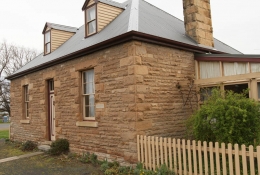
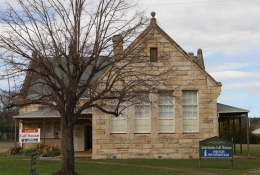
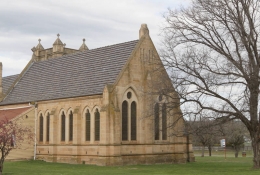
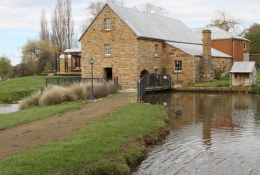
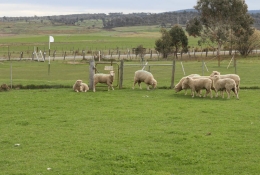
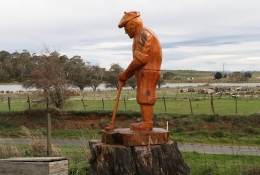



Nice blog, You’re doing a great job, Keep it up.
ReplyDeleteTrust registration process